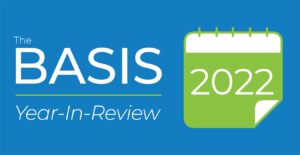At the Division on Addiction, a central part of our mission is to bring addiction science to a broad community of readers. For nearly thirty years, we’ve used The BASIS to further this mission. We’re proud of all that we achieved with The BASIS over this past year. Tens of thousands of people visited our site to learn about addiction science, and just over half were from the U.S. Other visitors were from the U.K., Canada, Australia, and many other countries.
Just as we’re always trying to diversify our audience, we also try to diversify the group of scholars whose work we elevate. We recently set ourselves a new goal: that at least half of the studies we review on The BASIS would be written by a member of a group traditionally underrepresented in science.1 The (U.S.) National Institutes of Health specifies three underrepresented groups: (1) individuals from minoritized racial/ethnic groups, (2) individuals with physical or mental disabilities, and (3) individuals from disadvantaged backgrounds. We added a fourth category, (4) individuals who identify as LGBTQ+. During 2022, at least 56% of our summaries featured research authored by individuals from at least one of these four categories. We look forward to continuing and advancing this approach during 2023.
We like to use these end-of-year reflections to spotlight our most-read posts.
Most Read Science Reviews
- The WAGER: The most widely-read WAGER summarized a study by Robert Heirene and colleagues demonstrating gamblers’ difficulty recalling their gambling spend and frequency. John Slabczynski, who summarized this study for The BASIS, says, “I think from a research point of view, this study shows that measurement is really important. Slight changes in how we choose to measure a variable may lead to inaccurate reporting and worse yet, bad science. From a public health perspective, it shows that we either need to implement systems that help people track their spending or shift the focus of responsible gambling strategies away from monitoring your own expenditure and towards more consistent methods like setting deposit limits.”
- ASHES: The most-read ASHES of the year discussed the influence of social networks on adolescent smoking. Caitlyn Matykiewicz says of the study she reviewed, originally written by Georges E. Khalil and colleagues, “It surprised me that the positive association between the number of smokers in one’s social network and smoking initiation was present even among the group of teens whose close friends were nonsmokers. I would like to know this group’s motives for smoking initiation, as that information could help inform prevention efforts. The study also found that smoking predicted closer relationships with smokers, so it would be interesting to learn whether or not this group of teens now have different close friends who smoke.”
- STASH: Kira Landauer wrote our most-read STASH this year, revealing that people driving to opioid treatment programs face much longer drive times compared to people seeking other kinds of healthcare, and that drive times to these treatment programs were much longer for rural communities compared to urban communities. Reflecting on this serious barrier to addiction treatment, Ms. Landauer says, “Opioid treatment programs require patients to receive their medication in person on an almost daily basis. Transportation can be significant barriers to treatment, especially for rural communities. I think this study’s findings illustrate the need to take a creative approach to improving treatment access. One approach would be to allow federally qualified health centers or dialysis centers, which have shorter average drive times than opioid treatment programs for both urban and rural communities, to administer medication for the treatment of opioid use disorder.” The original study was written by Paul Joudrey, E. Jennifer Edelman, and Emily A. Wang.
- The DRAM: Finally, our most-read DRAM of the year summarized a study originally written by Kerry Lee and colleagues exploring the combination of toxic childhood stress, addiction, and intimate partner violence among Black men. Writer Nakita Sconsoni observes, “I think these findings are so important because they shine a light on the experiences of an understudied demographic. To me, the most surprising finding was that alcohol use predicted higher odds of engaging in intimate partner violence among men who reported no adverse childhood experiences (ACEs). This seems contrary to what one might assume. However, the authors speculated that the traumatic repercussions of ACEs may have dulled the effects of adult alcohol use, meaning that men who did not endure the damaging effects of ACEs may be more susceptible to the disinhibiting effects of alcohol.”
Op-Eds
The BASIS also provides space for experts of diverse backgrounds, including treatment providers, policy makers, and people with lived experience, to share their views. Last week, we published an op-ed from Dr. Martina Whelshula, a member of the Arrow Lakes Nation of the Colville Confederated Tribes in Washington State with expertise in counseling psychology and Tribal Traditional Knowledge. Dr. Whelshula discussed efforts to build Tribal communities’ collective knowledge about mental health and addiction challenges, as part of a broader endeavor to help these communities heal from intergenerational colonial trauma. We also published an op-ed from Dr. Abigail Helm of the University of Massachusetts Chan Medical School. Dr. Helm described the need for comprehensive treatment that addresses the diverse needs of people experiencing co-occurring substance use and mental health disorders. She provided an overview of a new NIH-funded evaluation of the MISSION model, which integrates assertive outreach, group therapy for mental health and substance use, and peer support with linkages to community recovery services and activities.
We look forward to all that 2023 holds for The BASIS! Be on the lookout for a major redesign of our site and a new continuing education opportunity, alongside our continued efforts to share addiction science widely.
— The BASIS Team
________________
[1] We defined “writers” as the first or last author of every journal article we reviewed.





